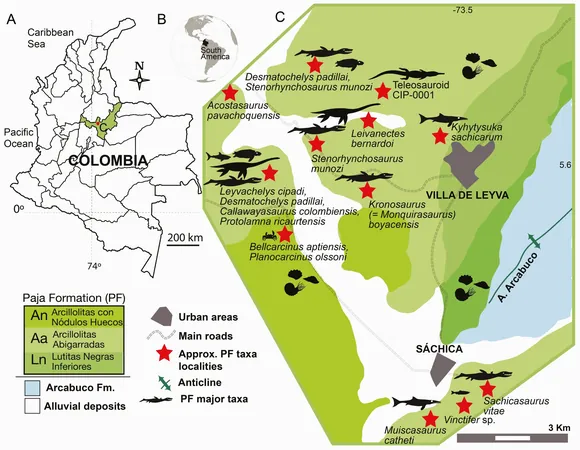
Ancient Marine Giants: The Fearsome Predators of Colombia's Prehistoric Oceans!
2025-01-13
Author: Olivia
Introduction
Imagine a time 130 million years ago when titanic marine reptiles reigned supreme in the oceans of what is now Colombia, ruling over their aquatic domains with an unparalleled ferocity that dwarfed today’s apex predators like killer whales and great white sharks. A groundbreaking study from McGill University reveals astonishing insights into the intricate marine ecosystem of the Cretaceous period, shedding light on a world teeming with colossal carnivorous creatures.
Paleontological Discoveries in the Paja Formation
Published in the Zoological Journal of the Linnean Society, this captivating research delves into the Paja Formation in central Colombia, where fossils paint a vivid picture of marine life that dominated the ancient seas. The findings indicate that these prehistoric oceans supported predators exceeding 10 meters in length, engaging in a complex food web that extended beyond the six trophic levels observed in today’s oceans, reaching an astonishing seventh trophic level!
Understanding Trophic Levels
Trophic levels are crucial for understanding the dynamics of ecosystems, determining the hierarchical relationships between species based on their energy sources. While modern marine life is classified into a maximum of six levels—where apex predators like killer whales swim at the top—the Paja Formation showcased a breathtaking diversity that suggests an even more tumultuous evolutionary arms race among species long before human existence.
Research Methodology
The meticulous research team at McGill University constructed an intricate network of ancient ecosystems based on a variety of fossils found within a single geological formation. By examining body sizes, feeding adaptations, and drawing parallels with contemporary oceanic life, the researchers created a comparative framework that provides valuable insight into these ancient marine ecosystems. They based their network against a reference system derived from the complex, vibrant ecosystems in today's Caribbean waters.
The Mesozoic Era: A Time of Diversity
The Mesozoic era, specifically the Cretaceous, was a time of dramatic geological change marked by rising sea levels and tropical climates. This led to an explosion of life in marine environments, filled with formidable species such as plesiosaurs and ichthyosaurs, alongside a rich variety of invertebrates that contributed to one of history’s most diverse marine food webs.
Significance of the Research
Dirley Cortés, the lead author and a dedicated doctoral student in Biology, emphasized the significance of the research, stating, “Our study is pioneering in unraveling the ecological interactions of this ancient ecosystem. Understanding this complexity reveals the evolutionary paths ecosystems have taken over millions of years and highlights the foundational structures that bolster today’s rich biodiversity.”
Co-author and Biology Professor Hans Larsson remarked on the implications of the research, stating, “These findings illuminate the evolutionary processes through intense trophic competition that have shaped the present biodiversity of our oceans.”
Impacts and Future Research
Importantly, this research represents just the tip of the iceberg. With few fossil ecosystems having had their food webs thoroughly reconstructed, this study opens the door to new opportunities for exploration and comparison across time and space. It promises to enhance our understanding of ancient marine life and its lasting impact on the intricate balance of our modern oceans.
Conclusion
Stay tuned—who knows what other exciting revelations about our planet's prehistoric past are waiting to be uncovered? The ocean's depths may hold secrets yet untold, waiting for the right explorers to discover them!



 Brasil (PT)
Brasil (PT)
 Canada (EN)
Canada (EN)
 Chile (ES)
Chile (ES)
 Česko (CS)
Česko (CS)
 대한민국 (KO)
대한민국 (KO)
 España (ES)
España (ES)
 France (FR)
France (FR)
 Hong Kong (EN)
Hong Kong (EN)
 Italia (IT)
Italia (IT)
 日本 (JA)
日本 (JA)
 Magyarország (HU)
Magyarország (HU)
 Norge (NO)
Norge (NO)
 Polska (PL)
Polska (PL)
 Schweiz (DE)
Schweiz (DE)
 Singapore (EN)
Singapore (EN)
 Sverige (SV)
Sverige (SV)
 Suomi (FI)
Suomi (FI)
 Türkiye (TR)
Türkiye (TR)
 الإمارات العربية المتحدة (AR)
الإمارات العربية المتحدة (AR)